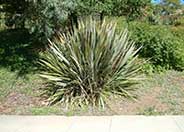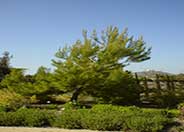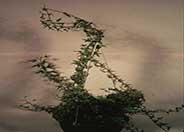
Common name:New Zealand Flax
Botanical name:Phormium tenax
New Zealand Flax is a large, bold plant with stiffly vertical, sword-like, green leaves that arise from its base. It should be grown under full sun for best color. Varieties will offer different growth habits and leaf color.
Maintenance Tips
Phormium tenax is a perennial that grows as a clump with strap-like leaves. This is a very popular plant and has many different hybrids that are selected for their different foliage colors, sizes, and textures. When growing this species, there is a lot of genetic variety, so the size of the mature plant can range from 2' up to 8'. To keep the maintenance as low as possible, plant in a location that is full sun, and well-drained and give it the space it needs to reach maturity. These plants are often the victim of poor pruning habits, with gardeners cutting the leaves off in the middle or shearing them because they are too large for the space they have been given. If this is the case, they should be transplanted to a location where they can reach their full size, or other plants around them should be moved out of their way.
Common name:Aleppo Pine
Botanical name:Pinus halepensis
Aleppo Pine (Pinus halepensis) is a Mediterranean native tree with an upright growth habit, reaching up to 60’ tall and 40’ wide. This tree is often planted in California parks and gardens because of its drought tolerance and its natural vertical shape. This tree is too large for small gardens, but it would be appropriate in medium-to-large gardens that have the space to support it. Its natural, upright growth habit makes it very low maintenance, requiring almost no shaping or pruning when it is young. Once it has been in place for a few years, the pruning should be left to a licensed arborist to keep the tree looking and performing at its best. This tree should be planted at least 10 feet away from any hardscape areas, 30 feet from structures such as houses and buildings, and not near any powerlines. Shrubs and perennials should be planted about five feet away from this tree. It should be irrigated for about 45 minutes once a week when using most in-line drip irrigation systems. It is not recommended for fire-prone areas. Visit the Orange County Fire Authority for more information.

Common name:Lavender Cotton
Botanical name:Santolina chamaecyparissus
This ground cover/small shrub will grow to 2' tall and has small, grayish silver leaves with yellow flowers that bloom in the summer.
Maintenance Tips
Santolina chamaecyparissus is a Mediterranean native that can be found in many California gardens. It is very drought tolerant and is very low maintenance if it is planted in a location where it can reach its full mature size of 2’ tall to 3’ wide. This plant is susceptible to root rot or fungal diseases if the soil is too wet or doesn’t drain easily. If the plant develops fungal issues, allow the soil to dry out and treat with a systemic fungicide. This plant usually blooms in the summer, and the plant will continue to bloom if you deadhead the spent flowers. In the late winter or early spring, you can cut back the foliage by one-third of the current size to maintain the size and encourage new growth.
Common name:Needlepoint English Ivy
Botanical name:Hedera helix 'Needlepoint'
This ground cover will grow about 6"-12" high and makes a great alternative for lawns. It has bright green leaves and is deer resistant.
Photographer: GardenSoft
Practice grass-cycling by leaving short grass clippings on lawns after mowing, so that nutrients and organic matter are returned to the soil.
Mulching and adding compost to soil can minimize evaporation and help soil absorb and store water.
Drip and other smart irrigation delivers water directly to roots, allowing no excess water for weeds.